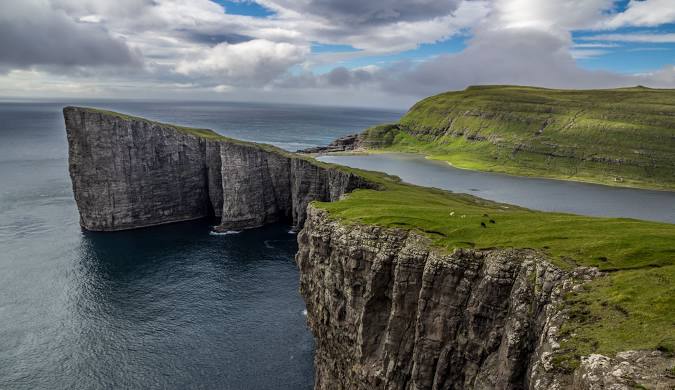Faroe Islands, Denmark
🏔️ Faroe Islands – Europe’s Most Dramatic Secret
⭐ 9.1/10 | Nature | Photography | Off-the-Beaten-Path
Eighty shades of green, mist-covered mountains, puffin cliffs, and waterfalls tumbling into the sea—welcome to the Faroe Islands, where every view is unreal.
✨ Why Visit the Faroe Islands?
Tucked between Iceland and Norway, the Faroe Islands are a remote archipelago of 18 volcanic islands ruled by sheer cliffs, roaring seas, and ethereal beauty. Part of the Kingdom of Denmark, this destination is a paradise for adventurers, photographers, and travelers craving solitude, authenticity, and raw nature.
You won’t find crowded cities or chain hotels—just dramatic landscapes, tiny turf-roof villages, and an atmosphere that feels straight out of fantasy fiction.
🏞️ Top Natural Attractions
| Destination | Why Visit |
|---|---|
| Múlafossur Waterfall | Iconic waterfall dropping into the sea in Gásadalur—truly postcard-perfect. |
| Saksun | A remote village with turf houses, a black-sand tidal lagoon, and mountainous backdrops. |
| Mykines Island | Puffin paradise and one of the best hiking islands; don’t miss the lighthouse hike. |
| Lake Sørvágsvatn | The famous "optical illusion" lake that appears to float above the ocean. |
| Kalsoy Island | Nicknamed the "James Bond island" (No Time To Die), home to the striking Kallur lighthouse. |
| Gjógv | A cozy northern village with a natural sea gorge and perfect hikes. |
🥾 Best Activities
-
Hiking: Trails range from short walks to full-day summit climbs with insane coastal views.
-
Birdwatching: Spot puffins, gannets, and arctic terns from cliffsides (especially in summer).
-
Photography: The whole country is a canvas of light, mist, and drama.
-
Village Hopping: Discover turf-roof houses, remote communities, and Faroese hospitality.
-
Boat Tours: Sail under sea stacks and into sea caves around Drangarnir and Vestmanna cliffs.
🍽️ What to Eat
Faroese cuisine is fresh, rustic, and often fermented. Must-tries include:
-
Skerpikjøt – wind-dried mutton, a local delicacy
-
Ræstur fiskur – fermented fish with potatoes
-
Langoustines & Mussels – fresh from the cold waters
-
Føroya Bjór – the national beer brand
-
Heimablídni dinners – home-hosted meals offered by locals for authentic island flavors
🌍 Practical Info
-
Getting There: Flights to Vágar Airport from Copenhagen, Reykjavík, Edinburgh, and more.
-
Getting Around: Rent a car for the best flexibility. Undersea tunnels connect most islands.
-
Language: Faroese and Danish; English widely spoken.
-
Currency: Faroese króna (pegged to the Danish krone).
🏨 Where to Stay
-
Luxury: Hotel Føroyar – hilltop views above Tórshavn
-
Mid-range: Gjaargardur Guesthouse Gjógv – cozy, family-run with epic scenery
-
Unique: Turf-roof cabins on Airbnb or local homestays in villages
📸 Top Photo Spots
-
📍 Múlafossur Waterfall
-
📍 Lake Sørvágsvatn “Floating Lake”
-
📍 Mykines cliffs with puffins
-
📍 Kallur Lighthouse at sunset
-
📍 Saksun’s tidal lagoon
📅 Best Time to Visit
-
May to September: Best weather, birdwatching, and hiking access
-
June–August: Long daylight hours and puffin nesting season
-
Winter (October–March): Dramatic light and solitude, though many roads may be icy or closed
-
🌧️ Weather & Climate
-
The weather is famously unpredictable. Locals joke that you can experience all four seasons in one day.
-
Rain and mist are common—bring waterproof clothing, hiking boots, and layers.
-
Temperatures range from 3°C (winter) to 13°C (summer).
🏞️ Hidden Gems & Local Secrets
-
Sea Cave Concerts – Acoustic concerts in natural sea caves (usually in Klæmintsgjógv) in summer months.
-
Heimablídni – Faroese for “home hospitality.” Book a local dinner with islanders to experience true Faroese cuisine and storytelling.
-
Sandoy Island – Less visited but full of hidden trails, black-sand beaches, and folk legends.
🐑 Fun Facts About the Faroes
-
Sheep outnumber people 2:1 (population ~54,000, sheep ~80,000).
-
Faroese people have their own language, flag, and traditions.
-
The roads are incredibly safe and scenic—tunnels go under the ocean, and driving here is an adventure itself.
-
There are no McDonald’s or Starbucks—everything is locally owned.
🛫 Getting There
-
By Air: Direct flights to Vágar Airport from:
-
Copenhagen, Reykjavik, Edinburgh, Bergen, Paris (seasonal)
-
Carrier: Atlantic Airways (Faroese national airline)
-
-
By Sea: Smyril Line ferry from Hirtshals (Denmark) to Tórshavn (via Iceland)
🚘 Getting Around
-
Rent a car – essential for exploring freely; roads are safe but weather can challenge visibility
-
Tunnels – Most inter-island tunnels are free; some (like Eysturoyartunnilin) require a toll
-
Helicopter service – Government-subsidized flights between smaller islands (affordable but must be booked in advance)
💡 Travel Tips
-
Don’t rely only on Google Maps – bring offline maps or ask locals
-
Respect nature and wildlife – this is a fragile environment
-
Most places accept credit cards – no need to carry much cash
-
Book accommodation early – limited supply, especially in summer
-


